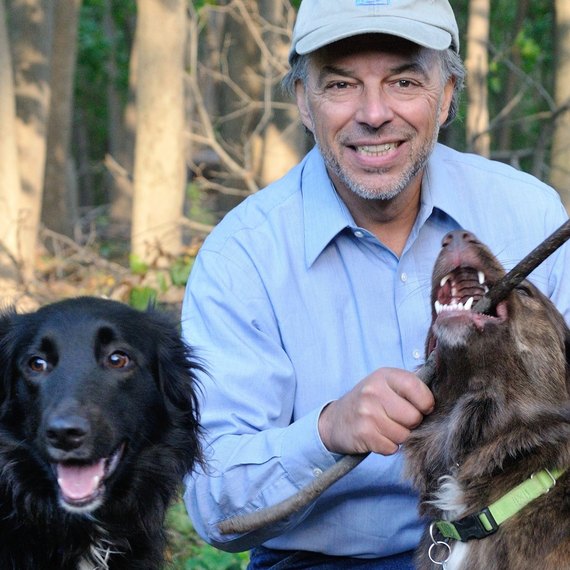"Does my dog love me, or does she just want a treat?" I'm often asked this question, and I've asked it myself. Hasn't any dog-lover?
It says something about our insecurity that our main question about them is whether they love us; it's always about us. But what do they feel? What emotions do they experience? Can we even know?
When someone says you can't attribute human emotions to animals, they forget the key leveling detail: Humans are animals. (We have to keep reminding ourselves, because we're only human.) Human sensations are animal sensations. Inherited sensations, using inherited nervous systems.
All of the emotions we know of just happen to be emotions humans feel. But our emotions help us understand other animals' pleasure, pain, sexuality, hunger, frustration, self-preservation, defense of territory and of young.
But OK; doesn't that lead us right back to old assumptions? Not if we incorporate all we've learned. Consider romantic love. It is obvious that elephants, with their matriarchal families, wandering males, absence of male-female pair bonds, and no male care of young, don't have romantic love. So, evidence and logic can be trustworthy guides. In fact, the word for evidence plus logic is: science.
We never seem to doubt that an animal acting hungry feels hungry. What reason is there to disbelieve that an elephant who seems happy, is happy? We can't really claim scientific objectivity when we recognize hunger and thirst while they're eating and drinking, exhaustion when they tire, but deny them joy and happiness as they're playing with their children and their families. Yet the science of animal behavior has long operated with that bias--and that's unscientific. When they seem joyous in joyful contexts, joy is the simplest interpretation of the evidence. Their brains are similar to ours, they make the same hormones involved in human emotions--and that's evidence too. So let's not assume. But let's not insist on wearing blinders and ignoring all the evidence.
Brain scans show that core emotions of sadness, happiness, rage or fear, and motivational feelings of hunger and thirst, are generated in "deep and very ancient circuits of the brain," says the noted neurologist Jaak Panksepp. Rage, for example, gets produced in the same parts of the brains of a cat and a human. Many species apparently share ancient brain-chemical systems largely unchanged during evolution. Makes sense; being afraid of lurking danger has obvious survival value for all kinds of animals. Humans might sometimes have "nothing to fear but fear itself," but we still feel it, because fear runs deep.
For further evidence of similar experience, consider that many animals respond similarly to mood-altering drugs. Rats can become addicted to the same euphoria-producing drugs that humans get addicted to. Dogs with compulsive behaviors respond to the same medications as do humans with obsessive-compulsive disorder. It's the same disease. Stressed animals' blood carries the same stress-related hormones as does the blood of stressed-out humans. Crayfish hide for extended periods after getting mild electrical shocks. Such crayfish showed elevated levels of serotonin--evidence of clinical anxiety. When researchers gave the crayfish a drug used to treat humans suffering from anxiety--chlordiazepoxide--they resumed normal crayfish activities and explorations. The researchers write, "Our results demonstrate that crayfish exhibit a form of anxiety." Perhaps one could consider administering chlordiazepoxide (or taking some) before throwing the next batch of live crayfish into boiling water. Or try the pasta.
One would expect so important a feeling as fear to arise early in the history of animals, and to be retained during evolutionary changes wherever predators may lurk. And that's what we see. Writes Panksepp, "The resemblances between basic animal and human emotions are truly remarkable." But what's remarkable is that this comes as a surprise to us. What else could we expect?
Rather than mistakenly attributing emotions that they do not experience, our larger mistake has been denying emotions that other animals do experience.
Chula as a puppy. Credit: Carl Safina
What if some other animals actually do feel sensations that we label with words like: anxiety, fear, rage, interest, affection, exuberance, depression, curiosity, playfulness, tenderness, lust, trust, love, jealousy, frustration, fairness--. Is it possible that humans alone feel all these things; that all other animals feel none of them? I don't think so. I'm not suggesting that humans and other animals have all the same emotions. Self-loathing seems uniquely human.
So, do other animals have human emotions? Yes, they do. Do humans have animal emotions? Yes. They are the emotions of shared brain structures and shared chemistries, originated in shared ancestry. They are the shared feelings of a shared world.
And love? If an animal comes to lick you and lie next to you, you might wonder whether they "love" you. I think it's a pretty reasonable to conclude that they do, considering the enormous range of emotions that we label with the word "love." Romantic love, parental love, infantile love, love of community, of country, love of food, of chocolate, love of books and education, of sports, the arts--. The word "love" is a catch-all phrase for so many different positive emotions. We say we love ice cream, a certain movie, practical boats and impractical shoes, or a summer's day. Some people love fighting. If we allow ourselves to be so sloppy with such a seemingly crucial word, then one conclusion is almost inescapable: Animals love. The more interesting question is: which animals, what do they love, and in what way? How do they experience it; what positive, gap-closing emotions do they feel?
An elephant approaches water anticipating the relief of refreshment and the pleasures of mud. When my puppy rolls on her back to get me to rub her belly again, it's because she anticipates the soothing experience of our warm contact. Even when our dogs aren't hungry, they always enjoy a treat. They enjoy it.
# # #
Carl Safina's most recent book, Beyond Words; What Animals Think and Feel, is newly out in paperback.




